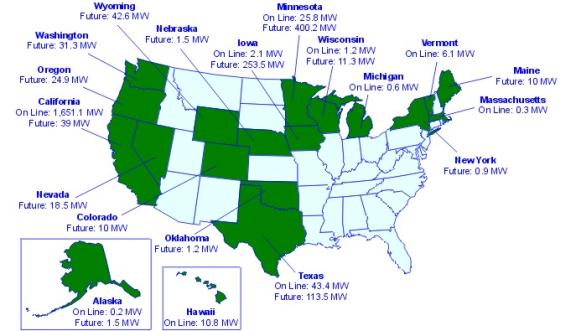Wind
power had almost disappeared until the 1970’s, when the energy crisis spurred
various governments into providing a combination of incentives to make wind
power more economical. Until very recently, the United States was the global
center of wind power, with over 80% of the world’s windmills in California
alone. From 1997 to 2000, Germany built so many wind turbines that it eclipsed
the United States as the leading country for wind generation. The table below
shows the top ten of wind power capacity installed at year-end 1998.
|
Country
|
Wind energy
year-end 1998
(MW)
|
Capacity installed
per capita
(W/p.c.)
|
Growth rate
1997-1998
(%)
|
|
Germany
|
2,875
|
35.1
|
38.2%
|
|
USA
|
1,820
|
6.8
|
8.8%
|
|
Denmark
|
1,448
|
275.3
|
26.1%
|
|
India
|
968
|
1.0
|
3.0%
|
|
Spain
|
707
|
18.0
|
38.1%
|
|
The Netherlands
|
361
|
23.3
|
13.2%
|
|
UK
|
333
|
5.7
|
4.4%
|
|
China
|
214
|
0.2
|
28.9%
|
|
Sweden
|
165
|
18.7
|
35.3%
|
|
Italy
|
154
|
2.7
|
49.5%
|
|
Others
|
517
|
|
|
|
Total
|
9,563
|
|
24.3%
|
Source: The German Wind Energy Association
United States
Today, California is still a major center for wind turbines. Winds, flowing
through various mountain passes at an average of seventeen miles per hour,
power over 16,000 windmills. This makes up about 1% of California’s electric
power supply, generating enough electricity for about 300,000 homes.
New wind
development has been taking place in Minnesota (247 MW of additional wind
turbines), Iowa (240 MW), Texas (146 MW), California (117 MW), Wyoming (73
MW), Oregon (25 MW), Wisconsin (23 MW), and Colorado (16 MW).

Canada
In 1999, Canada had a total of only 83 MW of installed wind capacity at seven
facilities. Four are located in Alberta (Cowley Ridge, Pincher Creek, Belly
River and Blue Ridge), two in Quebec (Mantane, Cape Chat), and one in Ontario
(Tiverton).
In June 1999, Toronto Hydro announced
that it would construct two 20-story waterfront windmills by the end of 2000.
The turbines, estimated to be powerful enough to generate electricity for
up to 1,000 homes, are to be used to help alleviate the growing air pollution
problems in Toronto, where smog and air quality advisories have been escalating
in recent years. The project has been estimated to cost about $816,327 (U.S.)
for each turbine. The Canadian government has provided $224,490 in funding
for one of the windmills, and another $67,000 has been donated by Environment
Canada.
Mexico
In 1999, Mexico had only 3.1 MW of wind power at four facilities. There are
plans to develop as much as 2,000 MW of wind capacity in southern part of
the Tehuantepec Isthmus.

Let’s have a look at Biomass. |